Minimum Power Input Control for Class-E Amplifier Using Depletion-Mode Gallium Nitride High Electron Mobility Transistor
Abstract
:1. Introduction
2. Materials and Methods
2.1. D-Mode GaN HEMT
2.2. Design of Charge Pump Gate Drive for D-Mode GaN HEMT
2.3. Class-E Amplifier Circuit
PWM Control and Circuit Response
2.4. Maximum Power Transfer
2.5. Minimum Power Input Control
3. Resonant WPT Results
4. Conclusions
Author Contributions
Funding
Institutional Review Board Statement
Informed Consent Statement
Data Availability Statement
Acknowledgments
Conflicts of Interest
References
- Sokal, N.O.; Sokal, A.D. Class E—A new class of high-efficiency tuned single-ended switching power amplifiers. IEEE J. Solid State Circuits 1975, SSC-10, 168–176. [Google Scholar] [CrossRef]
- Liu, M.; Zhao, C.; Song, J.; Ma, C. Battery Charging Profile-Based Parameter Design of a 6.78-MHz Class E2 Wireless Charging System. IEEE Trans. Ind. Electron. 2017, 64, 6169–6178. [Google Scholar] [CrossRef]
- Aldhaher, S.; Mitcheson, P.D.; Arteaga, J.M.; Kkelis, G.; Yates, D.C. Light-weight wireless power transfer for mid-air charging of drones. In Proceedings of the 2017 11th European Conference on Antennas and Propagation (EUCAP), Paris, France, 19–24 March; pp. 336–340.
- Chen, W.T.; Chinga, R.A.; Yoshida, S.; Lin, J.; Hsu, C.K. A 36 W wireless power transfer system with 82% efficiency for LED lighting applications. Trans. Jpn. Inst. Electron. Packag. 2013, 6, 32–37. [Google Scholar] [CrossRef] [Green Version]
- Chokkalingam, B.; Padmanaban, S.; Leonowicz, Z.M. Class E power amplifier design and optimization for the capacitive coupled wireless power transfer system in biomedical implants. Energies 2017, 10, 1409. [Google Scholar]
- Paolucci, M.; Green, P.B. Benefits of GaN e-Mode HEMTs in Wireless Power Transfer—GaN Power Devices in Resonant Class D and Class E Radio Frequency Power Amplifiers. October 2018. Rev 1.0. Infineon, White Paper. Available online: https://www.infineon.com/wirelesscharging (accessed on 17 October 2018).
- Green, P.B. Class-E Power Amplifier Design for Wireless Power Transfer. August 2018. Rev 1.2. Infineon, Appl. Note 1803. pp. 1–51. Available online: https://www.infineon.com/wirelesscharging (accessed on 10 August 2018).
- Akuzawa, Y.; Ito, Y.; Ezoe, T.; Sakai, K. A 99%-efficiency GaN converter for 6.78 MHz magnetic resonant wireless power transfer system. J. Eng. 2014, 10, 598–600. [Google Scholar] [CrossRef]
- Lee, S.H.; Yi, K.P.; Kim, M.Y. 6.78-MHz, 50-W wireless power supply over a 60-cm distance using a GaN-based full-bridge inverter. Energies 2019, 12, 371. [Google Scholar] [CrossRef] [Green Version]
- Yeh, C.H.; Lin, Y.T.; Kuo, C.C.; Huang, C.J.; Xie, C.Y.; Lu, S.F.; Yang, W.H.; Chen, K.H.; Lin, Y.H. A 70W and 90% GaN-based class-E wireless-power-transfer system with automatic-matching-point-search control for zero-voltage switching and zero-voltage-derivative switching. In Proceedings of the 2018 IEEE International Solid-State Circuits Conference-(ISSCC), San Francisco, CA, USA, 11–15 February 2018; pp. 138–140. [Google Scholar]
- Xie, C.Y.; Yang, S.H.; Lu, S.F.; Lin, F.Y.; Lin, Y.A.; Ou-Yang, Y.Z.; Chen, K.H.; Liu, K.C.; Lin, Y.H. 15.3 A 100W and 91% GaN-Based Class-E Wireless-Power-Transfer Transmitter with Differential-Impedance-Matching Control for Charging Multiple Devices. In Proceedings of the 2019 IEEE International Solid-State Circuits Conference-(ISSCC), San Francisco, CA, USA, 17–21 February 2019; pp. 242–244. [Google Scholar]
- Grebennikov, A. Load Network Design Techniques for Class E RF and Microwave Amplifier. High Freq. Electron. 2004, 3, 18–32. [Google Scholar]
- Barman, S.D.; Reza, A.W.; Kumar, N. Coupling Tuning Based Impedance Matching for Maximum Wireless Power Transfer Efficiency. J. Comput. Sci. Comput. Math. 2016, 6. [Google Scholar] [CrossRef]
- Jiang, C.; Chau, K.T.; Liu, C.; Lee, C.H. An overview of resonant circuits for wireless power transfer. Energies 2017, 10, 894. [Google Scholar] [CrossRef]
- Muharam, A.; Ahmad, S.; Hattori, R. Scaling-Factor and Design Guidelines for Shielded-Capacitive Power Transfer. Energies 2020, 13, 4240. [Google Scholar] [CrossRef]
- Minnaert, B.; Costanzo, A.; Monti, G.; Mongiardo, M. Capacitive Wireless Power Transfer with Multiple Transmitters: Efficiency Optimization. Energies 2020, 13, 3482. [Google Scholar] [CrossRef]
- Li, C.; Wang, B.; Huang, R.; Yi, Y. A Resonant Coupling Power Transfer System Using Two Driving Coils. Energies 2019, 12, 2914. [Google Scholar] [CrossRef] [Green Version]
- Wen, F.; Li, R. Parameter Analysis and Optimization of Class-E Power Amplifier Used in Wireless Power Transfer System. Energies 2019, 12, 3240. [Google Scholar] [CrossRef] [Green Version]
- Ng, W.T.; Yu, J.; Wang, M.; Li, R.; Zhang, W. Design Trends in Smart Gate Driver ICs for Power GaN HEMTs. In Proceedings of the 2018 14th IEEE International Conference on Solid-State and Integrated Circuit Technology (ICSICT), Qingdao, China, 31 October–3 November 2018; pp. 1–4. [Google Scholar]
- Ishibashi, T.; Okamoto, M.; Hiraki, E.; Tanaka, T.; Hashizume, T.; Kikuta, D.; Kachi, T. Experimental validation of normally-on GaN HEMT and its gate drive circuit. IEEE Trans. Ind. Appl. 2014, 51, 2415–2422. [Google Scholar] [CrossRef]
- Chou, P.C.; Cheng, S. Performance characterization of gallium nitride HEMT cascode switch for power conditioning applications. Mater. Sci. Eng. B Adv. 2015, 198, 43–50. [Google Scholar] [CrossRef]
- Wu, C.C.; Jeng, S.L. Simulation Model Development for Packaged Cascode Gallium Nitride Field-Effect Transistors. Crystals 2017, 7, 250. [Google Scholar] [CrossRef] [Green Version]
- Liu, C.Y.; Wang, G.B.; Wu, C.C.; Chang, E.Y.; Cheng, S.; Chieng, W.-H. Derivation of the Resonance Mechanism for Wireless Power Transfer Using Class-E Amplifier. Energies 2021, 14, 632. [Google Scholar] [CrossRef]
- Kim, T.-H.; Yun, G.-H.; Lee, W.; Yook, J.-G. Highly efficient WPT system with negative impedance converter for Q-factor improvement. IEEE Access 2019, 7, 108750–108760. [Google Scholar]
- Liu, S.; Liu, M.; Fu, M.; Ma, C.; Zhu, X. A high-efficiency Class-E power amplifier with wide-range load in WPT systems. In Proceedings of the 2015 IEEE Wireless Power Transfer Conference (WPTC), Boulder, CO, USA, 13–15 May 2015; pp. 1–3. [Google Scholar] [CrossRef]
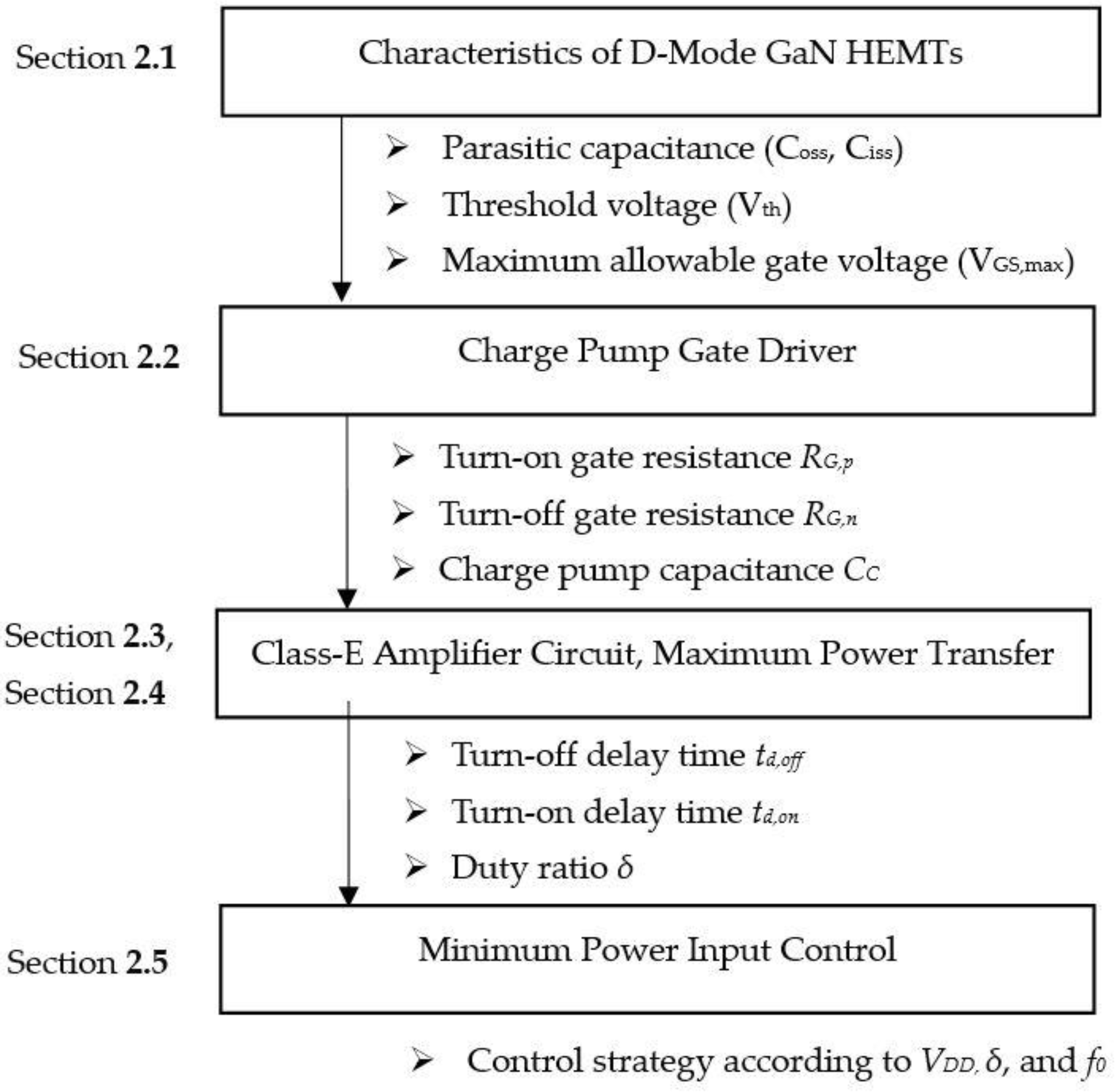


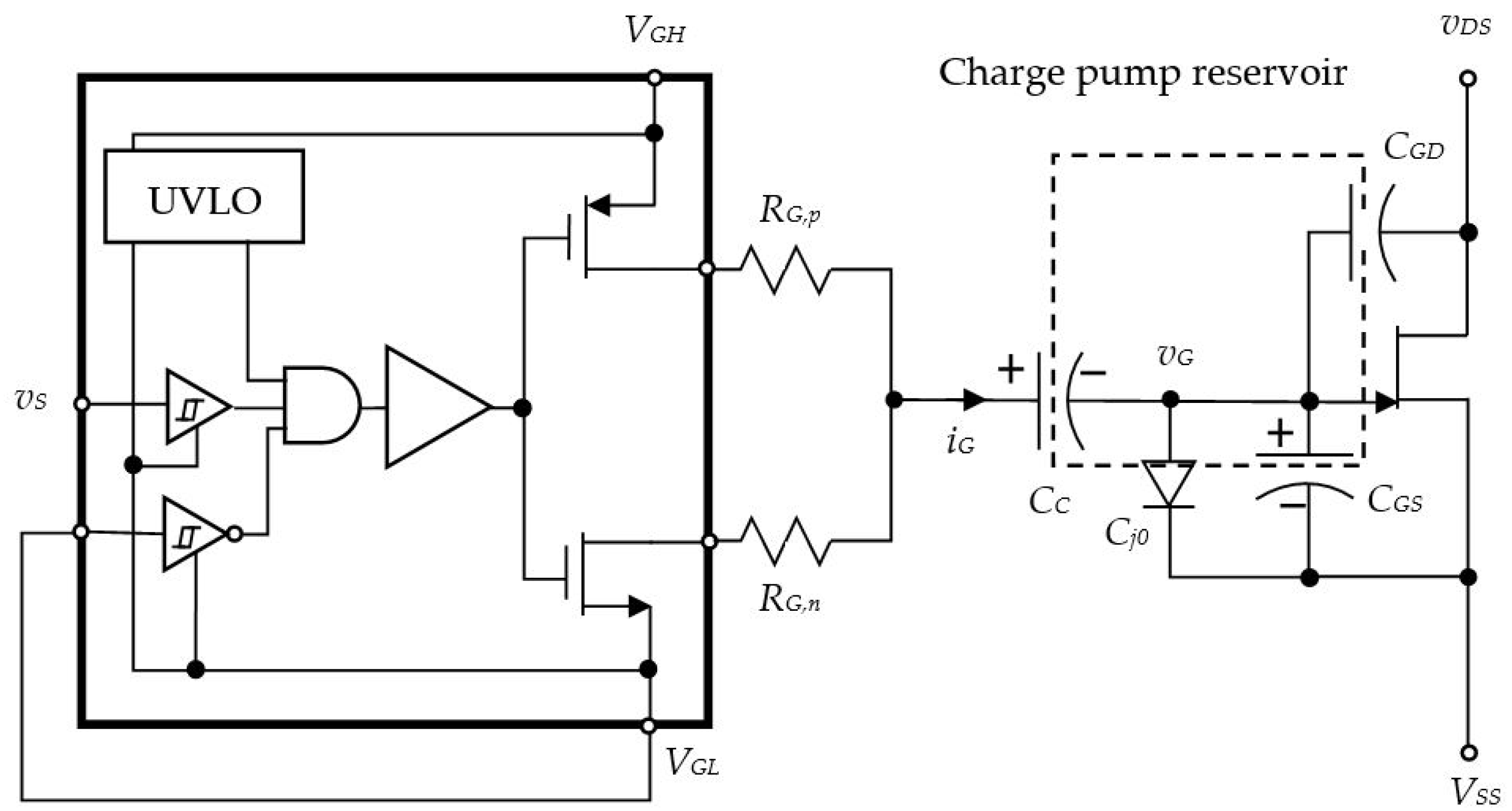

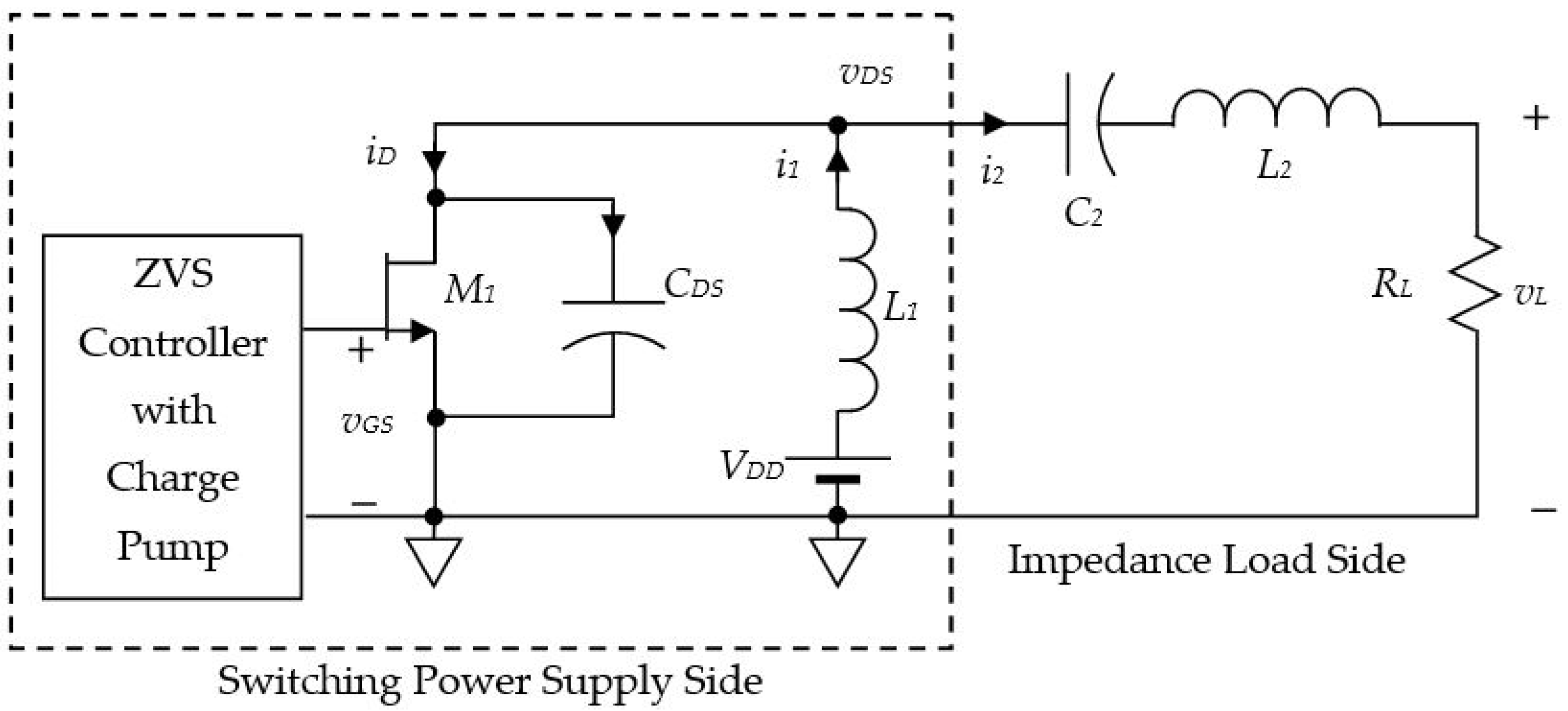
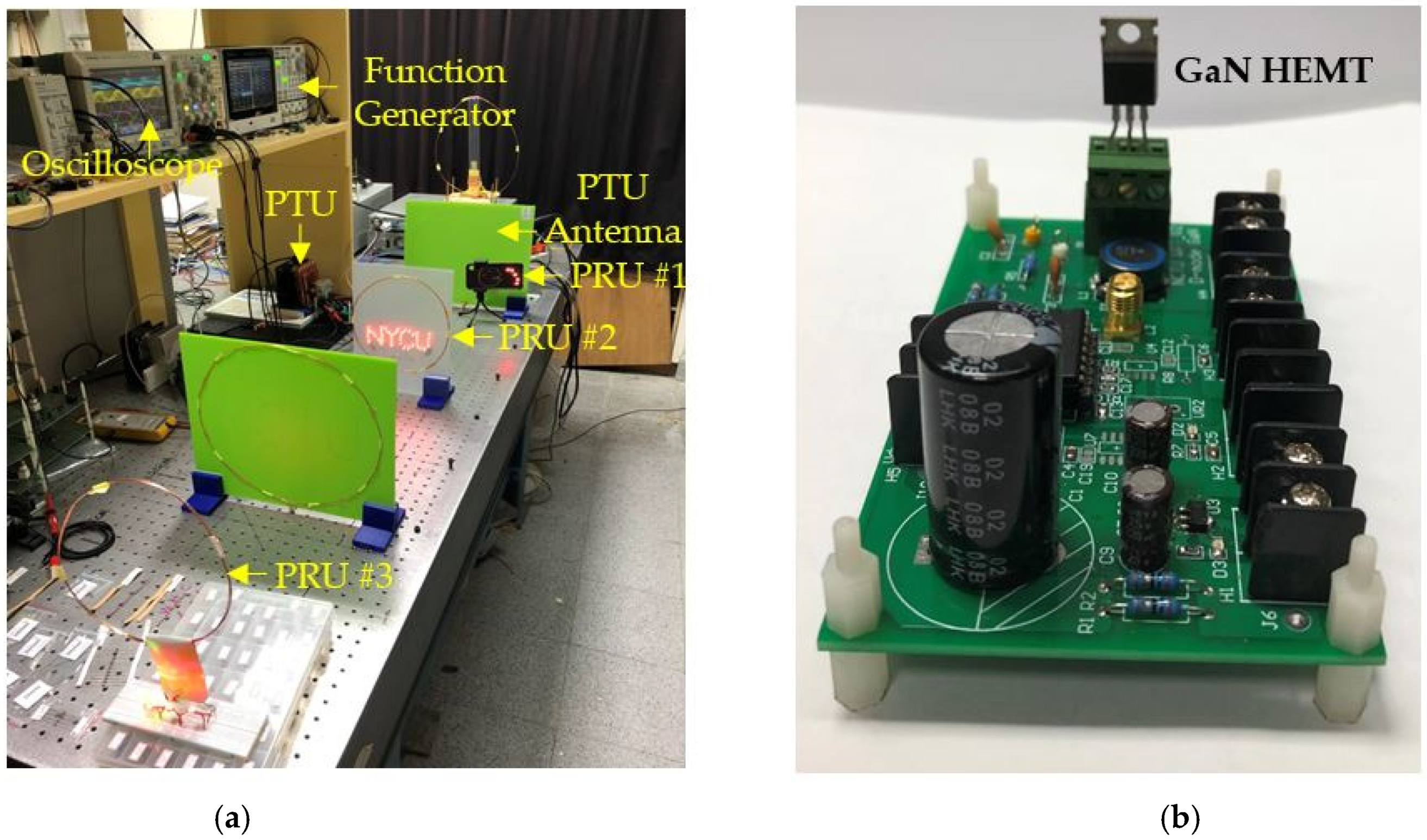




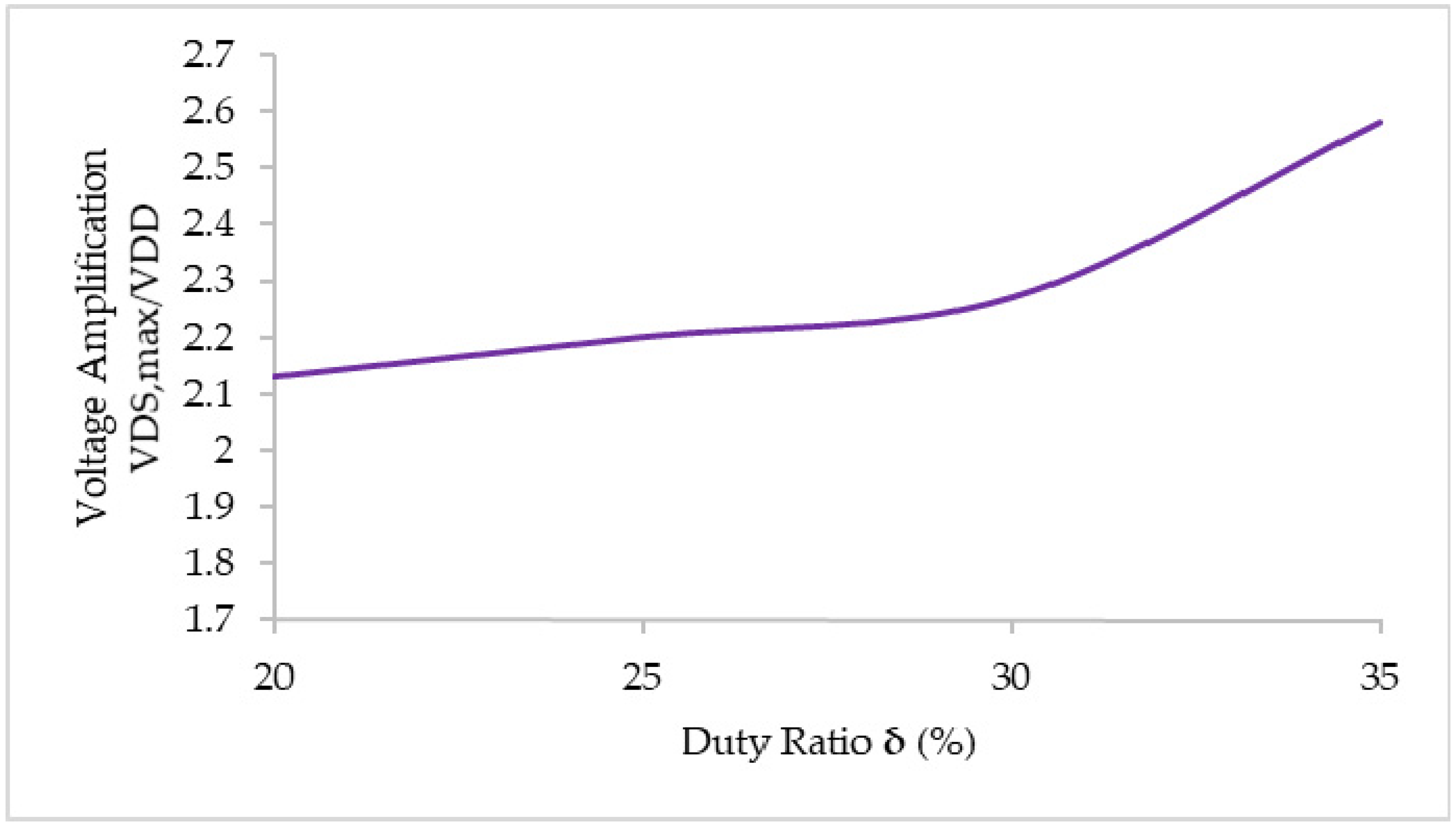


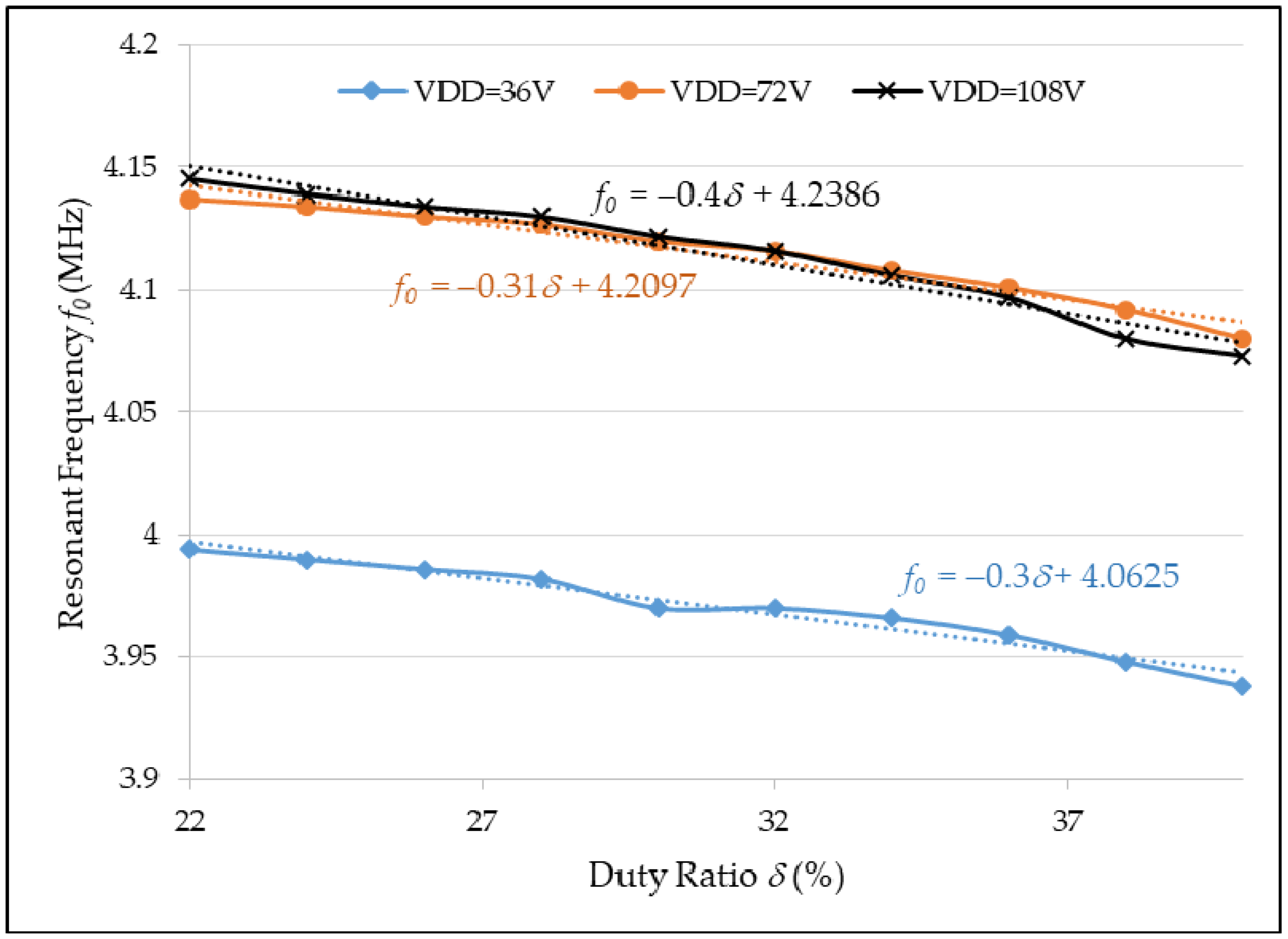


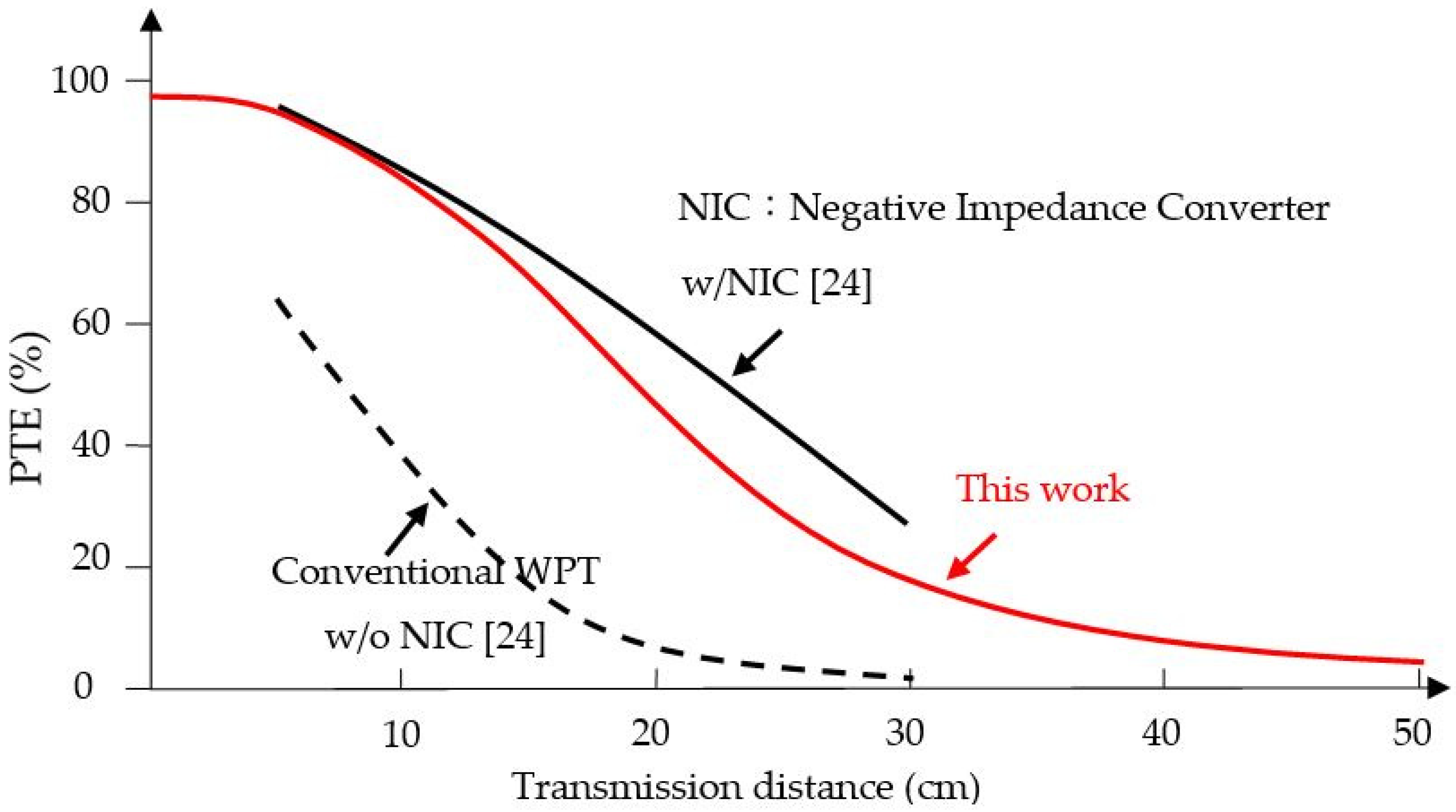
| Symbol | Parameter | Value | Unit |
|---|---|---|---|
| vGS,ON | Turn-on voltage | −7 | V |
| CDS | Drain-source parasitic capacitance | 100 | pF |
| CGD | Gate drain Parasitic capacitance | 80 | pF |
| CGS | Gate source Parasitic capacitance | 420 | pF |
| VGS,max | Maximum gate-source voltage | 8 | V |
| VDS,BD | Drain-source breakdown voltage | 1000 | V |
| id,max | Maximum drain current | 35 | A |
| Symbol | Parameter | Typical (pf) | Conditions |
|---|---|---|---|
| Ciss | Input capacitance | 99.7 | VDS = 150 V, VG = −10 V, T = 25 °C, 1 MHz |
| Coss | Output capacitance | 9.2 | |
| Crss | Transfer capacitance | 7.1 |
| Symbol | Parameter | Value | Unit |
|---|---|---|---|
| RG,p | Turn-on gate resistance | 12 | Ω |
| RG,n | Turn-off gate resistance | 30 | Ω |
| CC | Charge pump capacitance | 5 | nF |
| CGS | Diode capacitance | 40 | pF |
| IR | Diode reverse saturation current | 50 | µA |
| Symbol | Unit | Value |
|---|---|---|
| RL | kΩ | 5 1 |
| CDS | pF | 100 |
| C2 | pF | 75 |
| L1 | µH | 47 |
| L2 | µH | 8 |
Publisher’s Note: MDPI stays neutral with regard to jurisdictional claims in published maps and institutional affiliations. |
© 2021 by the authors. Licensee MDPI, Basel, Switzerland. This article is an open access article distributed under the terms and conditions of the Creative Commons Attribution (CC BY) license (https://creativecommons.org/licenses/by/4.0/).
Share and Cite
Weng, Y.-C.; Wu, C.-C.; Chang, E.Y.; Chieng, W.-H. Minimum Power Input Control for Class-E Amplifier Using Depletion-Mode Gallium Nitride High Electron Mobility Transistor. Energies 2021, 14, 2302. https://doi.org/10.3390/en14082302
Weng Y-C, Wu C-C, Chang EY, Chieng W-H. Minimum Power Input Control for Class-E Amplifier Using Depletion-Mode Gallium Nitride High Electron Mobility Transistor. Energies. 2021; 14(8):2302. https://doi.org/10.3390/en14082302
Chicago/Turabian StyleWeng, You-Chen, Chih-Chiang Wu, Edward Yi Chang, and Wei-Hua Chieng. 2021. "Minimum Power Input Control for Class-E Amplifier Using Depletion-Mode Gallium Nitride High Electron Mobility Transistor" Energies 14, no. 8: 2302. https://doi.org/10.3390/en14082302





